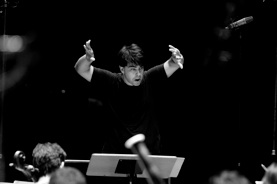
2010.04.26
“The Dream”
Dreams exist for a purpose. They mean something, but by their very nature, they don't follow the rules of reason. Yet, what is reason? Many cultures use dream as altered reality. As Pessoa shows, it is possible to use dreams creatively.
Amaral's approach is robust. His music is highly dramatic, full of assertive character, very much an active protagonist. The English translation is projected onto a backdrop, as if materialized straight off Pessoa's ancient typewriter, another invisible "person" operating in another dimension. Still, as in a dream, specific words don't matter so much as the overall emotional impact.
Pessoa (Jorge Vaz de Carvalho) appears. Like a master of ceremony, he opens the show with provocative words: "I see before me, in the transparent but real space of dream, the faces and gestures of Alberto Caeiro, Ricardo Reis and Álvaro de Campos" (the personalities, through which his work was channeled). They flank him, dressed like him, but clearly "not" him.
Salome is a role in a play Pessoa is writing, but now she becomes real. Carla Caramujo is a force of nature, her voice adding nuance and individuality to what she sings, even if the words don't make much sense. She lives in an enhanced dream state. It is a mystery to her why she is being asked for something so gruesome as the head of St John The Baptist, whom she recognizes as a kind of soul mate, for prophets dream of things that have not yet happened. But is the head she sees (we have to imagine it) that of the saint or a common criminal? Salome is never quite sure and that conflict is the essence of her dilemma.
Amaral's unusual choice of instruments integrates the ideas in the play into the music. He calls it "dédoublement" – more than simple shadowing. A disproportionately large number of cellos, which in theory might seem unbalanced, but in practice, works beautifully. They are led by a harp, deepened by double bass, xylophone and marimba. This is Salome's music, shimmering and sensual, but with a strong basic pulse in the harp (Helen Tunstall). Three flutes add a distinctive second "personality" – some very inventive passages there that might be developed in future works, perhaps. Amaral is still in his 30's but “O Sonho” is a surprisingly mature and assertive work. The subject matter may confuse on first hearing, but once you make the conceptual leap that meaning is beyond words, the music speaks for itself. One, particularly well written passage interplayed conventional singing with long, wordless ululation. It was mysterious, like a dream, yet also evoked a sense of the desert that surrounds Salome, where horizons dissolve in haze and the sands constantly shift their shape.
Amaral's music is very distinctive. It's hard to describe him in terms of others because he sounds so much himself. O Sonho really deserves to be heard again, better publicised and in a bigger hall. The staging, by Fernanda Lapa, is excellent too, showing how much can be done with minimal resources, if the person directing knows what opera is about. The whole cast, singing and non singing, on stage and off, seem passionately committed: this really feels like tight ensemble work.
The Gulbenkian Foundation was created by the Gulbenkian family who were genuine art lovers. They could have made an impact anywhere in Europe, but chose Lisbon, where the ambience fitted their cultivated, individualistic values. The Gulbenkians would be proud of what the Foundation does to promote works like “O Sonho”, iconoclastic but creative and very distinctive.

photo Andre Cameron


Last night at London's Robin Howard Dance Theatre the London Sinfonietta premiered Pedro Amaral's chamber opera “O Sonho”. It is based on an unfinished play by Fernando Pessoa, the eccentric genius of Portuguese literature. Pessoa's whole life was an art form. He is the Edgard Varèse of literature, pioneering new ways of interpreting reality and identity.







